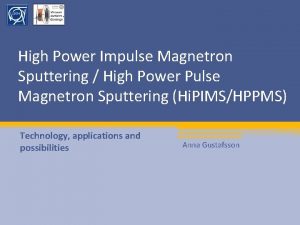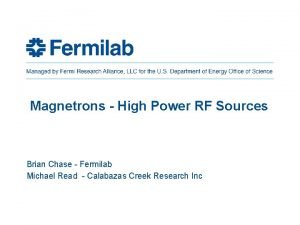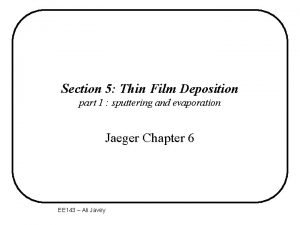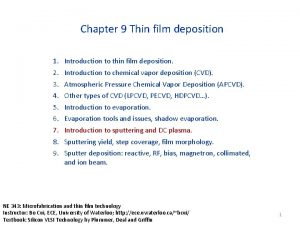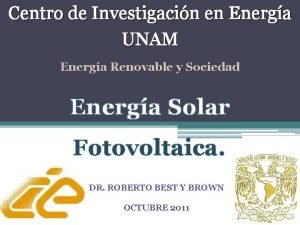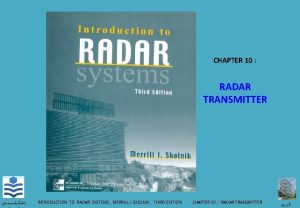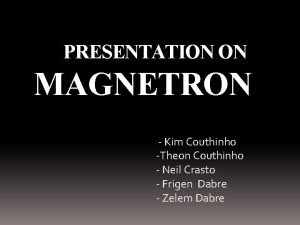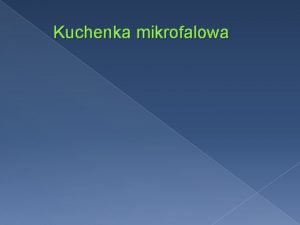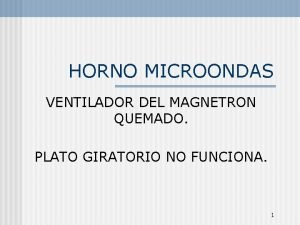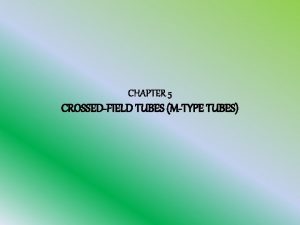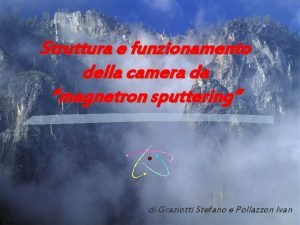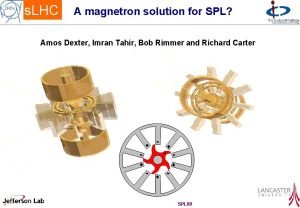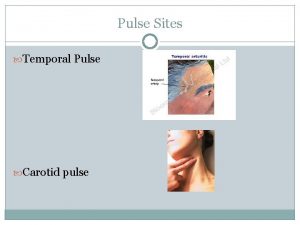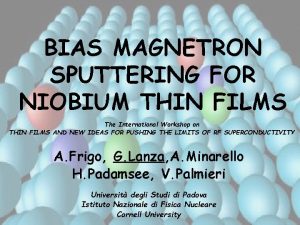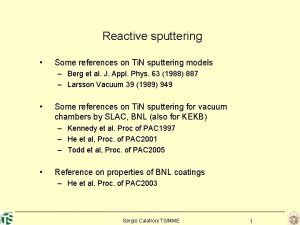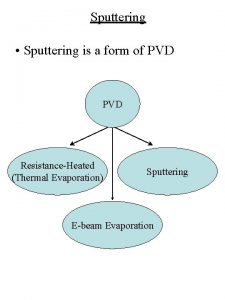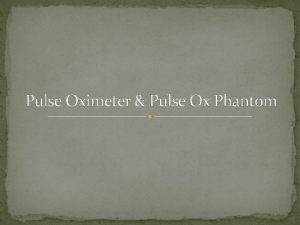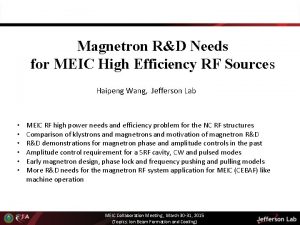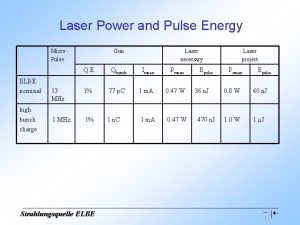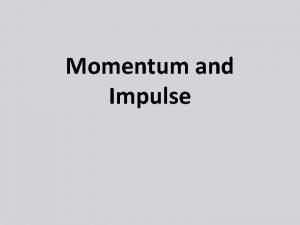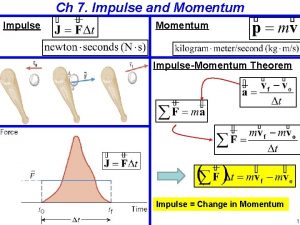High Power Impulse Magnetron Sputtering High Power Pulse















- Slides: 15

High Power Impulse Magnetron Sputtering / High Power Pulse Magnetron Sputtering (Hi. PIMS/HPPMS) Technology, applications and possibilities Anna Gustafsson

Overview • Introduction into Magnetron Sputtering • Hi. PIMS • Physical processes • Film properties • Applications • Pro’s and Con’s • The Hi. PIMS Power Supply • Summary & Outlook 2

Introduction: Magnetron Sputtering • Buffer-gas atoms (e. g. Ar or Kr) are ionized. The buffer-gas ions are then accelerated towards the target and sputter atoms out of the target. • The target atoms fly towards the substrate by the kinetic energy received in the sputter process. - - - - - -- - - - -- - For more details on the spectrum of dc. MS see Wil’s talk (13. 11. 09) 3

Hi. PIMS: Physical processes 4 • By applying pulses of high power the sputtered target material atoms are ionized Typical voltage and current trace from a high power pulsed magnetron discharge. Example of a duty cycle. J. Böhlmark et al. , J. Vac. Sci. Technol. A 23 (2005) 18

Hi. PIMS: Physical processes 5 • By applying pulses of high power the sputtered target material atoms are ionized → target material ions can be accelerated towards the target, higher kinetic energy upon arrival + + - + +- -+ -+ + - - +- -+ + --+ +- -+ --+- -+ - - + - + +- - + +- ++ + +- +- -+ -- +- +- -+ + + +-- - + The energy distribution for Ar+ and Ti+ U. Helmersson et al. , Thin Solid Films 513 (2006) 1 -24

Hi. PIMS: Physical processes • By applying pulses of high power the sputtered target material atoms are ionized → target material ions can be accelerated towards the target, higher kinetic energy upon arrival → ions are directed to the surface, thus non-flat surfaces can be sputtered with good conformity of the film + + + ++ + + - +- + +- - + -+ +- +- + + ++ + - + + +- +- -+ + + -+ -- +- -+ +- -- -+ + + + - +- - --+ -+ - - - + -- ++- + + 6

7 Hi. PIMS: Ionization • High ionization percentage • Typical values: > 90 % ionization of Ti, for Nb ~ 60 %. Nb and Ti have comparable ionization energies (6. 88 e. V and 6. 83 e. V). • Ionized target atoms can return to the target and cause self sputtering Optical emission spectra of dc. MS and Hi. PIMS discharge Courtesy: A. Anders, LNL A. Anders, AVS 56 th International Symposium 2009, SE 2 -Mo. M 8 K. Burcalova et al. , J. Phys. D: Appl. Phys. 41 (2008) 115306 U. Helmersson et al. , Thin Solid Films 513 (2006) 1 -24

Enhanced properties of films with Hi. PIMS dc. MS Hi. PIMS 8 Comment SEM image of a Ti. Si-C film SEM image of a Ta film grown on Si. J. Alami et al. , J. Vac. Sci. Technol. A 23 (2005) 278 J. Alami et al. , Thin Solid Films 515 (2006) 1731

Industrial applications of Hi. PIMS 9 • Hi. PIMS can be used on large cathodes (up to 1 m length). • Semiconductor applications (trench filling). • Sputter etching and implantation of Cr and Nb for enhanced adhesion of hard coatings. • Improved wear behaviour of Hi. PIMS coatings of e. g. Cr. N and Cr 2 N coatings. Abrasive and sliding wear properties W. -D. Münz et al. , J. of. Phys: Conf Series 100 (2008) 082001

Benefits • Any existing magnetron sputtering system can be used for Hi. PIMS by connecting a Hi. PIMS power supply instead of the DC power supply. • Low average power at the target due to a long duty cycle. • High ionization factor. Ionization dependent on many factors. Typical values: > 90 % ionization of Ti, for Nb ~ 60 %. Nb and Ti have comparable ionization energies (6. 88 e. V and 6. 83 e. V). • Hi. PIMS can be used on large cathodes (up to 1 m length) • Improved film quality: better adhesion, higher density, decreased roughness, good conformity, increased (normal) conductivity have been reported. • Applicable to non-flat surfaces. 10

11 Drawbacks • (Usually) lower deposition rate than with dc. MS • More expensive power supply • Cathode size limited (HIE-ISOLDE) A. Anders, AVS 56 th International Symposium 2009, SE 2 -Mo. M 8

The power supply 12 HÜTTINGER Elektronik is the only available manufacturer of Hi. PIMS power supplies suitable for our systems and purposes • Average/Peak power: 20 k. W/ 2 MW • Peak current: 1 k. A • Peak voltage: 2 k. V • Output frequency: up to 500 Hz • Pulse length: up to 200 μs HIPIMS power supply requirements : parameters and breakthrough arc management solution, Pawel Ozimek, April 2009

Outlook • Establish a Hi. PIMS coating system for small samples by use of the DMS in Building 101, understanding the different parameters and optimize the system. • Produce Nb films on Cu samples to investigate superconducting properties as well as RF properties. • Investigations of the so-called Q-drop mechanism to possibly improve the performance of Nb film cavities by this new sputtering technique. • Tests of the Hi. PIMS PS on the HIE-ISOLDE coating system. Cathode is cylindrical and much bigger surface, thus the feasibility has to be tested. 13

Summary • Hi. PIMS will not replace the conventional DC method, due to it’s lower deposition rate and expensive power supplies. • Enhanced film properties gives an important complement to the existing systems. • Superconducting properties of Nb films have hardly been investigated yet, but the enhanced film properties give a promising hint of improvements. • The community is very convinced that Hi. PIMS is “the way to go” 14

Thanks for your attention References • J. Alami et al. , J. Vac. Sci. Technol. A 23 (2005) 278 • J. Alami et al. , Thin Solid Films 515 (2006) 1731 • A. Anders, AVS 56 th International Symposium 2009, SE 2 -Mo. M 8 • K. Burcalova et al. , J. Phys. D: Appl. Phys. 41 (2008) 115306 • J. Böhlmark et al. , J. Vac. Sci. Technol. A 23 (2005) 18 • V. Kouznetsov et al. , Surf. Coat. Technol. 122 (1999) 290 • W. -D. Münz et al. , J. of. Phys: Conf Series 100 (2008) 082001 • HIPIMS power supply requirements : parameters and breakthrough arc management solution Pawel Ozimek, April 2009 Review on Ionized Physical Vapor Deposition (IPVD): • U. Helmersson et al. , Thin Solid Films 513 (2006) 1 -24 15
 Magnetron sputtering
Magnetron sputtering High power cw magnetron
High power cw magnetron Sputter yield
Sputter yield Thin film deposition
Thin film deposition Advantages and disadvantages of dc sputtering
Advantages and disadvantages of dc sputtering 1-2-3
1-2-3 Selenio blanco de sputtering
Selenio blanco de sputtering Edomah
Edomah Radar transmitter
Radar transmitter Magnetron construction
Magnetron construction Phương pháp phún xạ
Phương pháp phún xạ Potocznie o kuchence do podgrzewania
Potocznie o kuchence do podgrzewania Magnetron quemado
Magnetron quemado Hull cut off equation for cylindrical magnetron
Hull cut off equation for cylindrical magnetron Magnetron funzionamento
Magnetron funzionamento Magnetron amplifier
Magnetron amplifier
